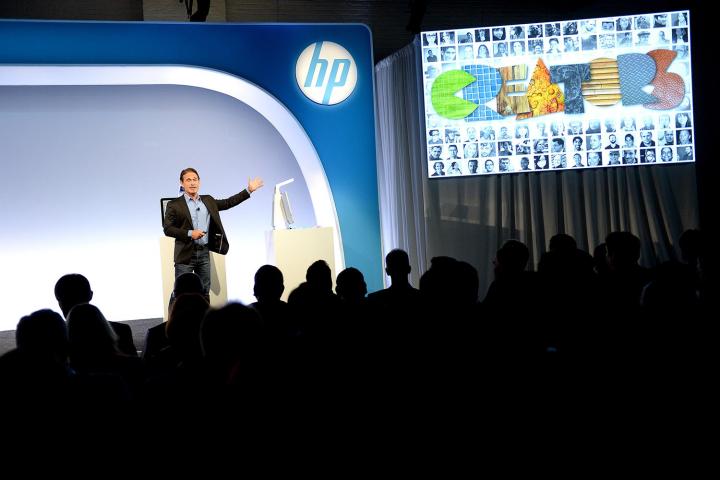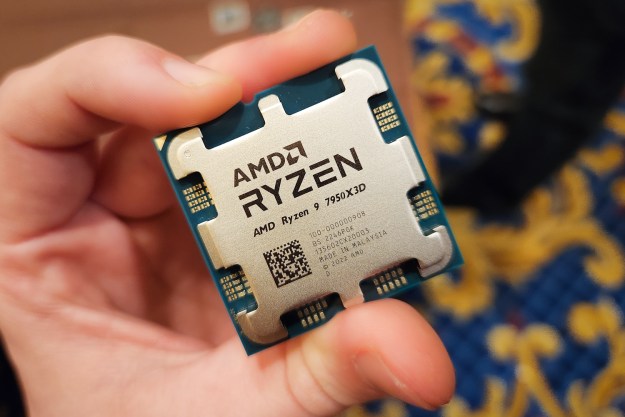
At an event in downtown New York City, HP recently announced the system, which melds a computer, camera, projector, and 3D scanner into an unusual looking all-in-one. This system, together with a touch-enabled mat that serves as a virtual work surface, is designed to radically change how people create things. The Sprout also gives users the ability to work closer together to conceive and complete a wide array of projects, whether those folks are 2 feet from each other or 2,000 miles apart.
At the weird product’s debut party, we spoke with Steve Smith — Director of Research and Development for the Sprout program — about what inspired this product, and what it may blossom into.
Digital Trends: What inspired HP to create the Sprout?
“They realized they had hit on something with two screens: a vertical screen and a horizontal canvas with multi-touch.”
In terms of the development process, it’s been everywhere from Flash demos and videos to try to understand what’s possible to building hardware and collaborating with companies like Texas Instruments to do projection and optical paths that are really important to the way that Sprout works.
So its been a combination of prototyping in software, prototyping in hardware, and learning until we got to a combination of things that really started to hit home in terms of capability.
What’s available right now, and what upcoming features will we see shortly?
Today we have 3D Snapshot available, which is a one-orientation 3D scan. It’s great for folks that want to do simple, creative things very quickly. Capture 3D objects, and import them into whatever creative application you want to use. That could be Powerpoint, that could be other applications.

In the future, with the full 360 scans, we’ll actually create files that can be printed with 3D printers. So it will be a fully multi-radial scan, fully fused and meshed, and ready for printing, sharing, and pulling into CAD files. It will be much more versatile.
We don’t have a final schedule for that yet, but I would say it’s coming soon.
Where do you see the Sprout being most prevalent? The classroom? Laboratories? With what audience?
Right now we’ve targeted the creatives, and I think we’re gonna get a lot of excitement from art directors and folks like that. I personally am excited about education, remote tutoring, and remote classrooms. Collaboration across geographies for businesses is going to be a very strong use case.
“One of the difficult things to do in engineering, especially on the creative side, is to collaborate across geographies.”
We have a number of first-party apps, which you saw today. We’re hoping that the developer community, once we release the SDK [software development kit], will be excited. We’re excited to learn what apps the development community comes up with, actually.
Do you see the Sprout being popular in fields like engineering and architecture?
Absolutely. One of the difficult things to do in engineering, especially on the creative side, is to collaborate across geographies. Sprout really breaks that barrier. We’re able to work on the same document in real-time across remote geographies. So I think that’s going to be an amazing capability.
Will the Sprout be upgradable? Or launched in more powerful configurations?
We are looking at next-generation versions of Sprout. We haven’t yet decided exactly how configurable we’ll make it. We could be going to future versions of Intel’s high-end processor. We’re looking at GPUs that we have, because that’s central to the experience as well.
What’s Intel’s role in the development of the Sprout?

Intel has been an integral partner. They have some of the 3D technology that’s in the device as well. We use an Intel depth sensor, and their camera system, so they’ve been integral to the product’s capabilities so far.
Are there any accessories that are going to be launched that are specific to the Sprout?
You’ll notice that the touch mat is actually removable. It snaps in and out, and magnetically snaps into place. It’s got a USB interface that the engineers designed that has power capabilities as well. We designed it that way for a reason. We can actually create accessories that would dock right in, either in place of the mat or to augment the mat. There are probably some things to be coming soon there.
What do you envision for the Sprout in the long term?
I think the great thing about Sprout is that it’s a very extensible platform. We’re still learning about everything that we can do. So we’re going to be creating new capabilities over what you saw today. Sometime — probably in the next six months or so –we’ll be introducing a full 360-degree scan capability. We have other things that we can do on the horizontal canvas that I’m not able to talk about right now. We’re going to continue to just break through the digital to physical barrier.
Editors' Recommendations
- Best 3D printer deals: Start printing at home for $159
- This HP laptop is discounted from $519 to $279
- Meta Quest 4: Here’s what we want from the next big VR headset
- The one AMD 3D V-Cache processor you should avoid at all costs
- Don’t miss this huge sale on HP printers — from just $50


